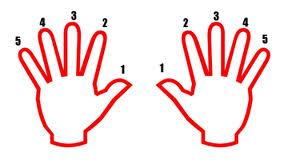
A student writes: "I have a fingering question. How do you suggest fingering major-7th arpeggios that continue over more than one octave, e.g. C-E-G-B-C-E-G-B-C. Up to now I have been using 1-2-3-4-1-2-3-4, however this does require a little stretch between 3 and 4. Would you consider this ok or would you recommend 1-2-3-5 and then the famous rebound from the 5th finger to 1?"
My response: Stretching to an extreme is never okay. In
most hands, playing a major third between 3 and 4 feels, at the very least, uncomfortable, though it is not impossible to work in. However, I play the C-major seventh chord with 5 on B when 1 is on C. Depending on the context, the thumb might also start on E:
 |
| Don't! |
 |
| Fingering Major 7ths |
Notice that there will be a shape in the direction of in to play the thumb and back out to play 5. This is particularly relevant when the thumb plays a black key. When 5 plays a black key, the shaping is reversed. Remember, fluency and speed are at issue here, and these only come when the hand is at ease.
No comments:
Post a Comment